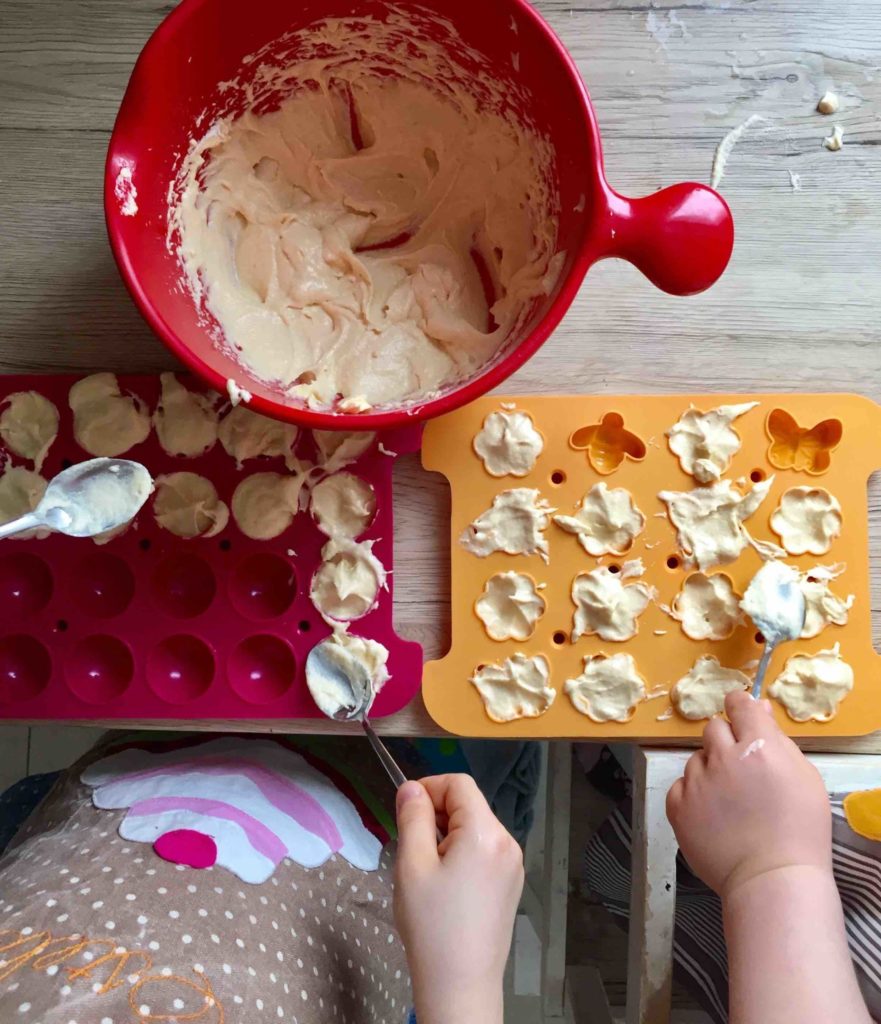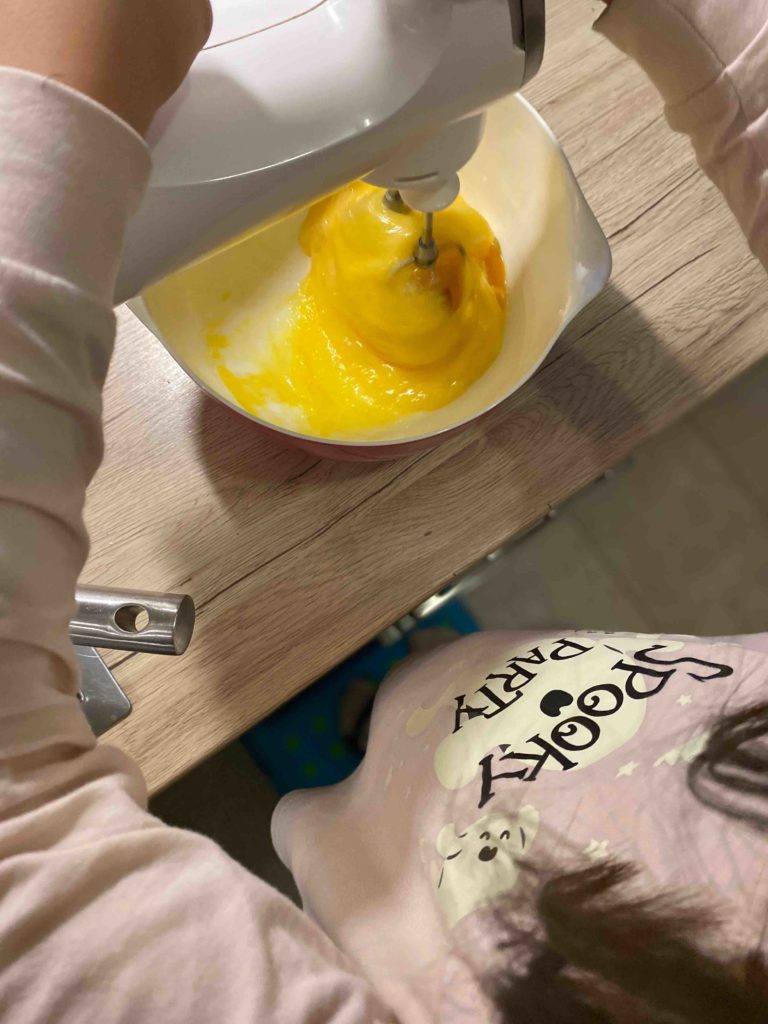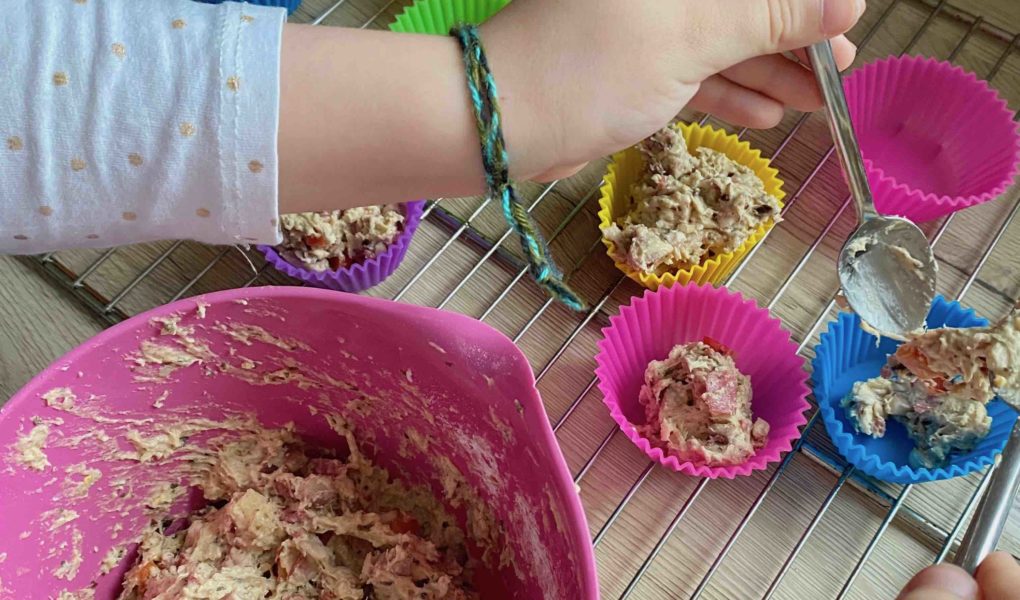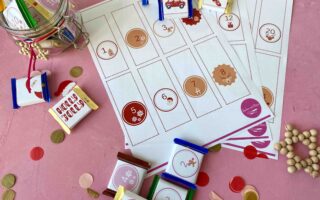*This posting contains advertising.
Safety when baking with children is the number one priority when baking with Minis. Here you’ll find my best tips & tricks for safe baking with kids!
In my opinion, there are countless reasons why you should get creative at the mixing bowl with your Minis. Fun and enjoyment are, of course, the main reasons, but there are many others—baking together can even strengthen your child’s self-confidence. (In my post “Baking with Kids: How Baking Can Support Your Child’s Development” you can read more about the benefits of baking with kids.)
But there’s one thing you should always keep in mind when baking with your Mini: safety comes first—especially in the kitchen! Working in the kitchen involves many potential hazards. With a little preparation and clear rules for everyone involved, you can reduce most risks right from the start.
In this post, I’ll share my tips & tricks for safe baking with children!
Think first, then bake!
Probably the most important tip for safe baking with kids! Before you dive into mixing with your Minis, take a moment to consider which tasks your child can already handle. A school-aged child is usually much more independent than a 3-year-old preschooler. (In my blog post “Baking with Kids: Age-Appropriate Tasks for Children from Age 2” you’ll find many ideas for how little ones can help in the kitchen.)
It also makes sense to adapt the baking process to your child’s age, attention span, and abilities. For example: plan short breaks, prepare certain steps in advance, or keep helpful tools within easy reach. (In my blog post “Baking with Kids: My Best Tips to Baking with kids”) I share my self-tested tips, which simplifies baking with your kids.)
Once you’ve thought through age-appropriate tasks and a smooth process, let’s take a closer look at possible hazards in the kitchen—and how to avoid them worry-free.

Safe baking with electronic devices
When working with electronic devices while baking with children, keep the following in mind:
- Cables should not hang down or lie in the way . A tugged cable can pull a mixer onto the floor or into little hands. Use cable protection* or store cords safely out of reach.
- Depending on your child’s age socket covers** should be installed . A spoon in an outlet can be disastrous.
- Mixers & hand mixers should only be used under adult supervision until school age. At my house, the rule is: both hands must hold the mixer handle—this gives better control and prevents fingers from getting caught in the beaters. If more than one child is baking, one holds the bowl firmly while the other mixes. Also: ingredients only go in when the mixer is turned off.
- Unplug deviceswhen not in use. Even a moment alone is enough for a curious child to switch one on.
Baking safely without cuts
The kitchen holds plenty of sharp tools. Here’s how to manage the essentials: !
- Grater – I generally don’t recommend graters for young children. Prepare this step yourself or use a safety holder* that protects fingers.
- Knives – Even adults cut themselves sometimes, but knives are unavoidable in the kitchen. Start with a blunt (spreading) knife and soft foods like bananas. Gradually move to firmer foods and sharper knives—always under supervision. There are special child-safe training knives*.*.
- Cookie cutters – Surprisingly, these can cause cuts too. If a child presses the wrong side down, the sharp edge can hurt. Explain clearly how to use them. Many cutters for kids have a colorful plastic rim* wunderbar erkennen lassen, welche Seite des Ausstechers auf den Teig gedrückt und welche in der Hand gehalten wird.

How to avoid burns while baking
Children’s skin is thinner and more sensitive than adults’. What feels lukewarm to you may already feel hot to them. So extra caution is needed:
- Hot oven – Ideally, your child can’t reach the oven door at all. If they can, the rule is: hands off! For older kids, always use oven mitts* (child-sized ones exist) and keep sleeves long and snug to avoid forearm burns.
- Hot pans & baking sheets – Let them cool somewhere out of reach, ideally in another room, pantry, balcony, or outside.
- Double boiler (water bath) – Melting chocolate or butter over hot water is dangerous for children. My tip: use the microwave instead! But be careful—melted candy melts can still burn.
- Pan handles – Always turn them to the back (toward the wall). Kids are fast, and pans tip over easily. A stove guard** can also help.

General tips for baking safety with kids
With small “rules” you can prevent many accidents in the kitchen:
- Explain hazards - explain hazards and set clear rules—though of course, kids may still “test” them. in der Küche, was passieren kann und welche Regeln es gibt. Das heißt natürlich nicht, dass dein Kind diese Regel nicht auch „austesten“ wird, dennoch hilft es, sich an Regeln zu orientieren.
- Supervise young children closely at all times .
- Avoid stress—accidents happen more easily when rushed.
- Keep hands free—don’t try to cook while holding a child. A learning tower* is a fantastic tool to safely involve kids at counter height. The learning towers are now available in all shapes and sizes*.
- Be a role model —children copy what they see.
- Runners and rugs in the kitchen are tripping hazards —so it's best to avoid them. If you don't want this, make sure the kitchen rug has a slip-resistant finish and adheres firmly to the floor*.
- Cabinet locks —store knives and cleaning products securely protected in a cabinet with a cabinet lock* .
- Keep toys out of the kitchen – Toys lying around in the kitchen can be a great tripping hazard or a distraction when working in the kitchen. If you can't avoid it completely, keep toys in a designated place and store them so they're not in plain sight when you're working in the kitchen (e.g., in a box or small chest).
Equipment for the Minis
When little ones help out in the kitchen, it can sometimes be quite difficult for them to manage utensils made for adults in their small hands. Equipping them with these tools is therefore also a major safety factor in the kitchen:
- Clothing – Wear fitted tops; roll up loose sleeves.
- Hair tied back – No loose hair, especially around mixers.
- Children’s baking sets* – Smaller spoons, bowls, and whisks are easier for little hands.

First aid in case of emergency
Even with precautions, accidents can still happen! Stay calm and treat the injury. I recommend keeping a small first aid kit* in the kitchen, including bandages, wound spray, and healing ointment* . Also, a first aid course for children is invaluable—many midwives or pediatric clinics offer these.
I hope my tips & tricks for safe baking with children were helpful to you. If you have more safety tips for baking with kids, feel free to share them in the comments.
I wish you and your little ones lots of fun baking safely!
Yours, Lia
BAKING NEWS – The most delicious thing right in your inbox?
Sign up for our newsletter and be the first to hear about colorful recipe ideas, easy baking hacks and upcoming baking promotions!



